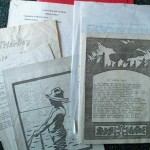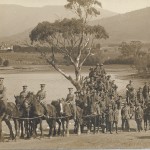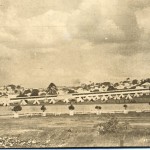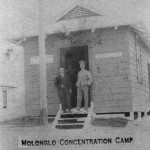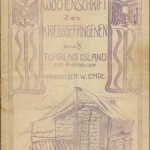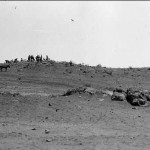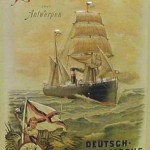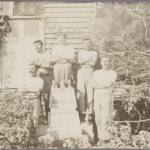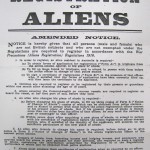Trial Bay Gaol, c.1915. Dubotzki collection, Germany The first group of Trial Bay internees disembark from the SS Yulgilbar in August 1915. Dubotzki collection, Germany The Trial Bay Gaol was not well prepared for the first internees who were accommodated … Continue reading
Soldiers training at the Claremont Army Camp in the First World War Courtesy State Library of Tasmania The temporary internment camp established in Tasmania was at Claremont then moved to Bruny Island. The camp had nearly fifty prisoners by early … Continue reading
The entrance to the camp at the Venereal Hospital at Langwarrin, Victoria, c.1915 – 1918. Courtesy Australian War Memorial Langwarrin Internment Camp was situated on the Mornington Peninsula, south-east of Melbourne. It housed up to 500 internees in poor conditions. … Continue reading
Enoggera Internment Camp, c.1915. Dubotzki collection, Germany Internees at Enoggera Internment Camp, c.1915. Dubotzki collection, Germany The Enoggera Internment Camp was located next to an existing army camp in suburban Brisbane, Queensland. It housed 140 internees, including the non-military officers … Continue reading
Internees in the old Bourke Gaol, c.1915. Dubotzki collection, Germany German families deported from the Straits Settlements (now Singapore and Malaysia), Ceylon (now Sri Lanka), Fiji and Hong Kong, as well as some local internees lived at Bourke in far … Continue reading
Molonglo Internment Camp Post Office, c.1918. Courtesy the National Archives of Australia The Molonglo camp was located outside of Canberra, in what was then called the Federal Capital Territory (now Australian Capital Territory). It was established late in the war … Continue reading
Torrens Island Internment Camp, c.1914 – 1915. Dubotzki collection, Germany The Torrens Island Internment Camp was a World War I concentration camp located on Torrens Island in the Port River Estuary near Adelaide in South Australia. Up to 400 ‘enemy … Continue reading
Rottnest Island is located off the coast of Western Australia near Fremantle. Rottnest Island had been used as a prison and then a tourist destination before the Commonwealth Government took it over at the outbreak of World War One for … Continue reading
The outbreak of fighting in Europe in August 1914 immediately brought Australia into the Great War. Within one week of the declaration of war, all German subjects in Australia were declared ‘enemy aliens’ and were required to report to the … Continue reading
On the 1st of January 1915, two men shot dead four people and wounded seven more, before being killed by the Police and Army. While the attack was apparently politically inspired, as the attackers confessed in notes they left behind, … Continue reading
Crews from German merchant ships captured in Australian ports at the outbreak of war were interned at Torrens Island, Rottnest Island and later moved to Berrima and Holsworthy Camps. The captured vessels included the Altona, Pfalz, Elass, Berlin, Prinz Sigismund, … Continue reading
Croatian internees at Rottnest Island Internment Camp 1915. Photo Karl Lehman. Courtesy National Library of Australia Of all internees in Australia, 21% came from Western Australia. This was the result of the mass internment of Austrian Slavs from the Kalgoorlie … Continue reading
From the 1850s German settlers escaping the rising nationalist sentiment in Germany began arriving in the Australian colonies looking to start a new life. Port Adelaide was the point of arrival for the majority of German settlers. The Germans moved … Continue reading
The lives of millions of Cambodians were devastated by the totalitarian Khmer Rouge Pol Pot regime. For every two people who survived, one person perished. About 8,000 Pol Pot survivors now live in New South Wales, mainly in Sydney. We … Continue reading
Registration of Aliens Poster, c.1917. Courtesy National Archives of Australia Germany was formed in 1871 when Bismarck united the German states. By 1914 it was a powerful country with a strong army but envious of Britain’s Navy and the empires … Continue reading
Paul Dubotzki: Photographer, Trial Bay c. 1916. Dubotzki collection, Germany In 1914, Paul Dubotzki left his home in Bavaria to accompany an expedition to Sumatra and China as expedition photographer. The outbreak of World War One took him by surprise … Continue reading
Credits Author Andrea Fernandes, NSW Migration Heritage Centre (MHC) Executive producer John Petersen, MHC Project management, research, interview*, text, edit, filming*, photography* Andrea Fernandes, MHC Web design & production Annette Loudon, MHC incorporating the Khmer Rouge Toons collection by Bunheang … Continue reading
Cambodia was devastated by the totalitarian Khmer Rouge Pol Pot regime. For every two people who survived, one person perished.
Now living in Western Sydney, six survivors share their memories. Watch participants reminisce about family loss and separation, freedom and safety through keepsakes and family photos in compelling video histories.
Germany was formed in 1871 when Bismarck united the German states. By 1914 it was a powerful country with a strong army but envious of Britain’s Navy and the empires of Britain and France. Although Britain had a large empire … Continue reading
Theau Yorth’s migration story (video) Download link Theau Yorth’s memorabilia (video) Download link cultural background Cambodian town, region, country of origin Pranet Preah, Battambang province, Cambodia start of migration journey Bangkok, Thailand on 22 December 1982 place of arrival in … Continue reading
Sovan Goldstraw’s migration story (video) Download link Sovan Goldstraw’s memorabilia (video) Download link cultural background Cambodian town, region, country of origin Prey Prom, Samrong, Takeo province, Cambodia start of migration journey Bangkok, Thailand on 24 November 1983 place of arrival … Continue reading
During World War One nearly 7000 so-called ‘enemy aliens’ were interned in camps in New South Wales. One was young Bavarian photographer Paul Dubotzki whose remarkable photographs record the experience of internment from 1915 to 1919. In 2007 his entire … Continue reading
next » Bookmark on DeliciousRecommend on FacebookShare with StumblersTweet about it
Timeline 9th – 15th century Khmer Angkor Empire dominates region. 16th – mid 19th century Treaty of protectorate signed with France. 1887 Cambodia becomes a colony. The French now administer the country. 1941-1945 Japanese occupation during World War Two. 1953 … Continue reading
» view at full size (3.6 Mb PDF file) Front page of the Australian Chinese Daily Issue No.1698 Tuesday, 6th June 1989 Brief translationsEditorial NO CIVIL WAR, NO VIOLENCE. According to news from Beijing, tanks and machine guns had already … Continue reading
The collection consists of personal ephemera brought to Australia by Italian Women chain migrating to Australia between 1920 and the 1970s. Continue reading
Lina Tjoeng’s migration story (video) Download link Lina Tjoeng’s memorabilia (video) Download link cultural background Cambodian town, region, country of origin Phnom Penh, Cambodia start of migration journey Kuala Lumpur, Malaysia in late 1975 place of arrival in australia Sydney … Continue reading
The Broken Hill Ottoman Flag is rare being unique and one a few items from the New Years Day attack at Broken Hill in 1915. Continue reading
Former mosque relocated from the Afghan Camp and later the cemetery in Broken Hill. Continue reading
The Greg Ritchie Negative Collection is a collection of over 3000 negatives featuring buildings and other sites in the City of Canterbury. Between 1990 and 1998 Canterbury City Council staff documented their day-to-day duties through photographs. Continue reading
